The global beverage clouding agent market is valued at USD 1.4 billion in 2025 and is expected to reach USD 2.8 billion by 2035, reflecting a CAGR of 7%. Market expansion is driven by rising demand for visually appealing beverages, increasing preference for clean-label and natural ingredients, and strong expansion of the non-alcoholic beverage sector. Additionally, growing health consciousness and consumer interest in organic and fruit-based drinks are supporting the uptake of beverage clouding agents.
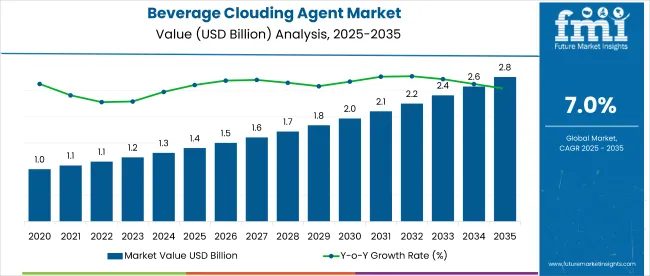
| Metric | Value |
|---|---|
| 2025 Market Size | USD 1.4 Billion |
| 2035 Market Size | USD 2.8 billion |
| CAGR (2025 to 2035) | 7% |
The market holds approximately 6% of the global beverage additives market and around 3% of the functional food ingredients market, reflecting its specialized role in enhancing beverage appearance and stability. Within the clean-label ingredients segment, its share is estimated at 2.5%, driven by the rising demand for natural formulations.
In the broader food and beverage ingredients market, beverage clouding agents contribute roughly 1.5%. Although relatively small in size, this segment plays a crucial role in value-added innovation within the competitive beverage formulation landscape.
Government regulations impacting the market focus on recent innovations centered around the development of plant-based, allergen-free, and sustainably sourced ingredients to meet evolving consumer preferences. Leading manufacturers are increasingly investing in fermentation-based technologies to produce nature-identical citrus flavors and clouding agents with improved dispersion and stability.
Additionally, the use of microbial-derived emulsifiers and encapsulation techniques is gaining traction, allowing for better shelf life and performance across a wide pH range. These advancements are enabling beverage brands to create visually appealing products while aligning with clean-label and eco-conscious trends.
The USA is projected to be the fastest-growing market, expected to expand at a CAGR of 5.8% from 2025 to 2035, driven by clean-label demand and the presence of key players. Citrus clouding agents will lead the preparation segment with a 68% share, while neutral property agents will dominate the property segment with 65% share in 2025. While, the UK and France markets are expected to grow at 5.4% and 5% CAGR, respectively.
The beverage clouding agent market is segmented into source, property, preparation, form, application, and region. By source, the market includes natural and synthetic. Based on property, the market is bifurcated into neutral and non-neutral (colored). By preparation, the market comprises citrus clouding agents and non-citrus clouding agents.
Based on form, the market includes oil-based and powder. Based on application, the market is categorized into instant beverages, fruit-based beverages, energy drinks, sports drinks, RTD, smoothies, and others (dairy-based beverages, malted drinks, and flavored water). Regionally, the market is classified into North America, Latin America, Western Europe, Eastern Europe, South Asia & Pacific, East Asia, and Middle East & Africa.
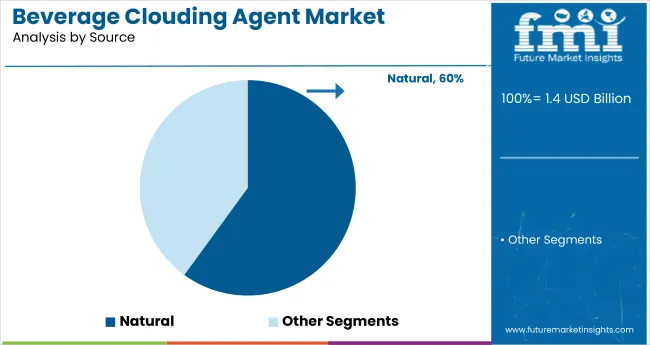
The natural is projected to lead the source segment with a 60% global market share in 2025. Growth is driven by increasing health consciousness, the proliferation of clean-label beverage options, and heightened demand for functional and aesthetically appealing drinks that align with wellness trends. Natural clouding agents, derived mainly from plant-based sources, are favored for their perceived safety, authenticity, and ability to support premium product positioning in juices, smoothies, and flavored waters.
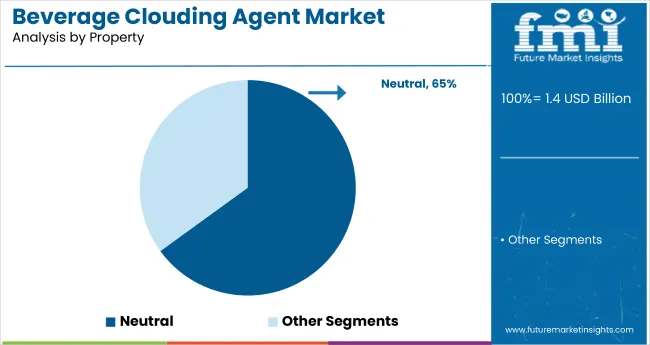
The neutral is expected to lead the property segment, accounting for 65% of the global market share in 2025. Growth is driven by surging consumer demand for aesthetically pleasing, functional beverages that maintain clarity and texture without altering the original flavor or acidity. Neutral clouding agents are particularly valued by manufacturers for providing a stable, cloudy appearance across diverse beverage applications, including juices, smoothies, and energy drinks, while supporting the shift toward clean-label and natural ingredients.
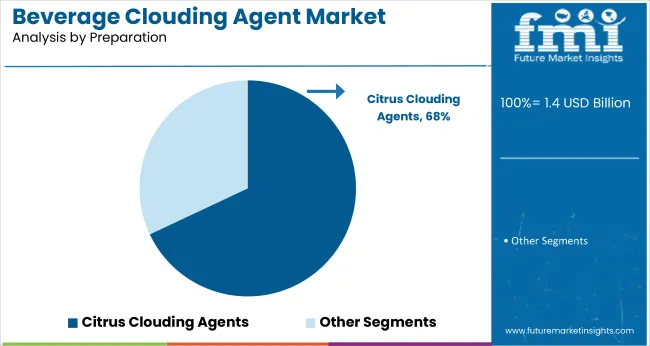
The citrus clouding agents are anticipated to dominate the preparation segment, accounting for 68% of the global market share in 2025. Growth is driven by the widespread use of citrus-based agents in fruit juices, flavored waters, and soft drinks due to their superior emulsification properties and natural appeal. Citrus clouding agents are preferred for their ability to enhance visual texture and deliver a refreshing appearance, aligning with the growing demand for clean-label and fruit-forward beverage formulations.
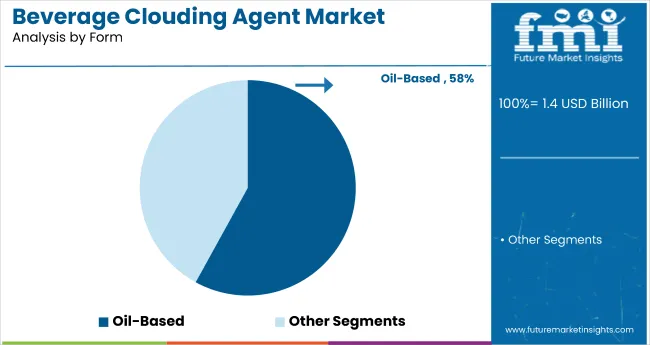
Oil-based is expected to lead the form segment, accounting for 58% of the global market share in 2025. Growth is driven by the superior emulsion stability and enhanced visual appeal offered by oil-based clouding agents, making them ideal for drinks like juices, energy beverages, and flavored waters. These agents effectively mimic the appearance of natural juice content while maintaining clarity and consistency, supporting their widespread application in both carbonated and non-carbonated beverages.
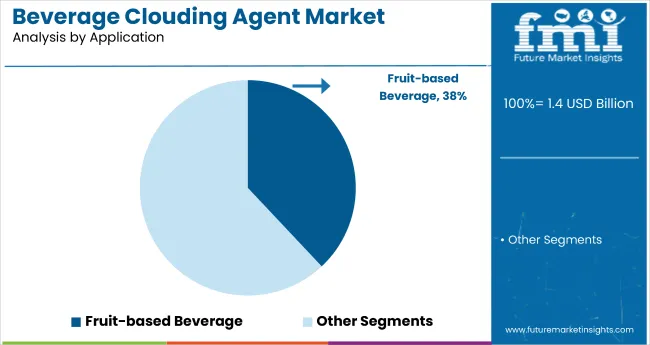
Fruit-based beverage is projected to dominate the application segment, accounting for 38% of the global market share in 2025. Growth is driven by increasing consumer preference for natural, refreshing, and visually appealing fruit drinks, including juices, nectars, and fruit-flavored waters. Clouding agents play a key role in enhancing the sensory appeal of fruit-based beverages by providing a rich, cloudy appearance that mimics freshly squeezed juice, supporting their popularity across both health-conscious and mainstream consumer segments.
The global market is growing steadily, driven by rising demand for visually appealing, clean-label beverages, increasing preference for natural and plant-based ingredients, and advancements in clouding formulations tailored for fruit-based and functional drinks.
Recent Trends in the Beverage Clouding Agent Market
Key Challenges in the Beverage Clouding Agent Market
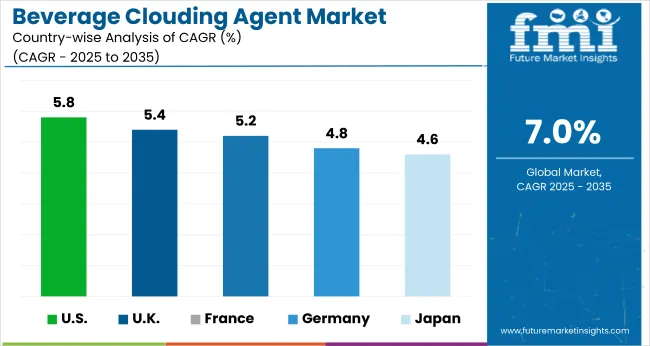
The USA leads the beverage clouding agent market, driven by clean-label trends and strong domestic players. The UK follows with a 5.4% CAGR, supported by demand for plant-based and wellness beverages. France maintains moderate growth at 5.2% CAGR, led by organic and premium drink trends. Germany is expected to grow at 4.8%, backed by a robust functional beverage sector, while Japan shows the slowest growth among the five, at 4.6% CAGR, due to its mature and technology-intensive beverage industry.
The report covers in-depth analysis of 40+ countries; with the five top-performing OECD nations highlighted below.
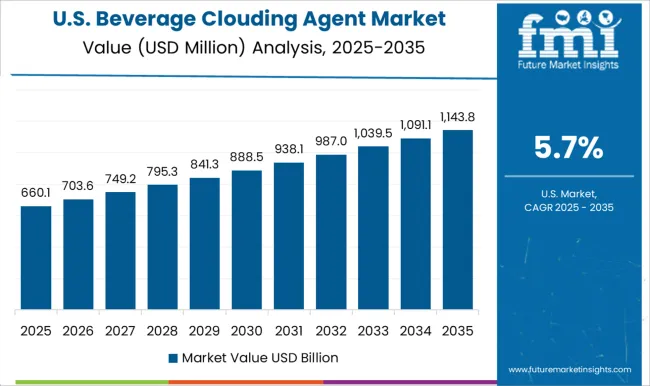
The USA beverage clouding agent market is projected to grow at a CAGR of 5.8% from 2025 to 2035, driven by a mature beverage industry and rising demand for natural, clean-label ingredients. Growth is further supported by increasing innovation in functional and plant-based beverages, where visual appeal plays a crucial role in consumer purchasing decisions.
Sales of UK beverage clouding agents are expected to expand at a CAGR of 5.4% from 2025 to 2035, supported by increasing consumer preference for plant-based drinks and functional beverages. Rising demand for clean-label and visually enhanced beverages is further encouraging manufacturers to adopt natural clouding agents across a variety of product categories.
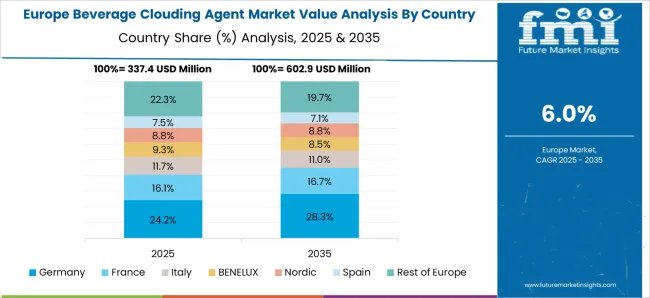
The demand for beverage clouding agents in Germany is projected to grow at a CAGR of 4.8% from 2025 to 2035, driven by the country’s strong functional beverage industry and preference for natural formulations. Increasing consumer interest in premium fruit juices, wellness drinks, and clean-label ingredients is further supporting the steady expansion of the market.
The beverage clouding agents market in France is projected to grow at a CAGR of 5.2% from 2025 to 2035, fueled by rising consumer demand for organic and visually appealing beverages. Growth is further supported by the expanding market for premium fruit-based drinks and the increasing adoption of natural emulsifiers in both carbonated and non-carbonated beverage formulations.
The Japan beverage clouding agents revenue is expected to grow at a CAGR of 4.6% from 2025 to 2035, supported by technological innovation and increasing demand for functional and aesthetically enhanced drinks. The trend toward minimalistic, clean-label ingredients is also driving the adoption of natural clouding agents in health-oriented and premium beverage offerings.
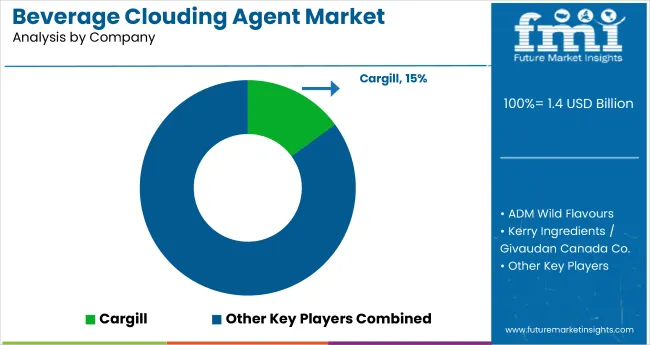
The global market is moderately fragmented, with leading players like Cargill, ADM Wild Flavours, and Kerry Ingredients holding significant market shares globally. These companies dominate through scale, integrated ingredient portfolios, and long-standing client relationships with beverage giants.
Top companies in the market are competing based on product innovation, cost efficiency, clean-label formulation, and strategic partnerships. While global players like Cargill and ADM are expanding their organic-certified and plant-based clouding solutions, companies like Givaudan and Chr. Hansen is focusing on natural emulsification technologies to align with clean-label and sustainability trends.
Recent Beverage Clouding Industry News
| Report Attributes | Details |
|---|---|
| Current Total Market Size (2025) | USD 1.4 billion |
| Projected Market Size (2035) | USD 2.8 billion |
| CAGR (2025 to 2035) | 7% |
| Base Year for Estimation | 2024 |
| Historical Period | 2020 to 2024 |
| Projections Period | 2025 to 2035 |
| Market Analysis Parameters | Revenue in USD billions/Volume in Metric Tons |
| By Source | Natural, and Synthetic |
| By Property | Neutral and Non-Neutral (Colored) |
| By Preparation | Citrus Clouding Agents and Non-Citrus Clouding Agents |
| By Form | Oil-Based and Powder |
| By Application | Instant Beverages, Fruit-Based Beverages, Energy Drinks, Sports Drinks, RTD and Smoothies, and Others (Dairy-based Beverages, Malted Drinks, Flavored Water, and Meal Replacement Beverages) |
| Regions Covered | North America, Latin America, Western Europe, Eastern Europe, South Asia and Pacific, East Asia, and the Middle East & Africa |
| Countries Covered | United States, Canada, United Kingdom, Germany, France, China, Japan, South Korea, Brazil, Australia, and 40+ countries |
| Key Players | Cargill, ADM Wild Flavours, Alano, Gat Foods, GLCC Co., Kerry Ingredients Givaudan Canada Co., Danisco (DuPont), Flachsmann Flavors and Extracts, and Chr. Hansen Holding A/S. |
| Additional Attributes | Dollar sales by product type, share by functionality, regional demand growth, regulatory influence, clean-label trends, competitive benchmarking |
The global beverage clouding agent market is estimated to be valued at USD 1.4 billion in 2025.
The market size for the beverage clouding agent market is projected to reach USD 2.7 billion by 2035.
The beverage clouding agent market is expected to grow at a 6.7% CAGR between 2025 and 2035.
The key product types in beverage clouding agent market are natural clouding agents and synthetic clouding agents.
In terms of property, neutral segment to command 62.7% share in the beverage clouding agent market in 2025.






Our Research Products

The "Full Research Suite" delivers actionable market intel, deep dives on markets or technologies, so clients act faster, cut risk, and unlock growth.

The Leaderboard benchmarks and ranks top vendors, classifying them as Established Leaders, Leading Challengers, or Disruptors & Challengers.

Locates where complements amplify value and substitutes erode it, forecasting net impact by horizon

We deliver granular, decision-grade intel: market sizing, 5-year forecasts, pricing, adoption, usage, revenue, and operational KPIs—plus competitor tracking, regulation, and value chains—across 60 countries broadly.

Spot the shifts before they hit your P&L. We track inflection points, adoption curves, pricing moves, and ecosystem plays to show where demand is heading, why it is changing, and what to do next across high-growth markets and disruptive tech

Real-time reads of user behavior. We track shifting priorities, perceptions of today’s and next-gen services, and provider experience, then pace how fast tech moves from trial to adoption, blending buyer, consumer, and channel inputs with social signals (#WhySwitch, #UX).

Partner with our analyst team to build a custom report designed around your business priorities. From analysing market trends to assessing competitors or crafting bespoke datasets, we tailor insights to your needs.
Supplier Intelligence
Discovery & Profiling
Capacity & Footprint
Performance & Risk
Compliance & Governance
Commercial Readiness
Who Supplies Whom
Scorecards & Shortlists
Playbooks & Docs
Category Intelligence
Definition & Scope
Demand & Use Cases
Cost Drivers
Market Structure
Supply Chain Map
Trade & Policy
Operating Norms
Deliverables
Buyer Intelligence
Account Basics
Spend & Scope
Procurement Model
Vendor Requirements
Terms & Policies
Entry Strategy
Pain Points & Triggers
Outputs
Pricing Analysis
Benchmarks
Trends
Should-Cost
Indexation
Landed Cost
Commercial Terms
Deliverables
Brand Analysis
Positioning & Value Prop
Share & Presence
Customer Evidence
Go-to-Market
Digital & Reputation
Compliance & Trust
KPIs & Gaps
Outputs
Full Research Suite comprises of:
Market outlook & trends analysis
Interviews & case studies
Strategic recommendations
Vendor profiles & capabilities analysis
5-year forecasts
8 regions and 60+ country-level data splits
Market segment data splits
12 months of continuous data updates
DELIVERED AS:
PDF EXCEL ONLINE
Clouding Agents Market Trends - Growth Factors & Industry Analysis
Analysis and Growth Projections for Beverage Flavoring Agent
Food and Beverages Color Fixing Agents Market Analysis by Product Type, Application and Region through 2035
Beverage Metal Can Market Size and Share Forecast Outlook 2025 to 2035
Beverage Packaging Market Size and Share Forecast Outlook 2025 to 2035
Beverage Carrier Market Size and Share Forecast Outlook 2025 to 2035
Beverage Cartoners Market Size and Share Forecast Outlook 2025 to 2035
Beverage Filter Paper Market Size and Share Forecast Outlook 2025 to 2035
Beverage Ingredients Market Analysis - Size and Share Forecast Outlook 2025 to 2035
Beverage Packaging Equipment Market Size and Share Forecast Outlook 2025 to 2035
Beverage Packaging Machine Market Size and Share Forecast Outlook 2025 to 2035
Beverage Premix Market Size and Share Forecast Outlook 2025 to 2035
Beverage Acidulants Market Size and Share Forecast Outlook 2025 to 2035
Beverage Refrigeration Market Size and Share Forecast Outlook 2025 to 2035
Beverage Tester Market Size and Share Forecast Outlook 2025 to 2035
Beverage Dispenser Market Size and Share Forecast Outlook 2025 to 2035
Beverage Container Market Size and Share Forecast Outlook 2025 to 2035
Beverage Can Ends Market Size and Share Forecast Outlook 2025 to 2035
Beverage Cups Market Size and Share Forecast Outlook 2025 to 2035
Beverage Can Seamers Market Size and Share Forecast Outlook 2025 to 2035

Thank you!
You will receive an email from our Business Development Manager. Please be sure to check your SPAM/JUNK folder too.
Chat With
MaRIA